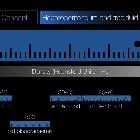Computertomographie
Computed tomography (CT) scanning, also known as, especially in the older literature and textbooks, computerized axial tomography (CAT) scanning, is a diagnostic imaging procedure that uses x-rays to build cross-sectional images ("slices") of the body. Cross-sections are reconstructed from measurements of attenuation coefficients of x-ray beams in the volume of the object studied.
CT is based on the fundamental principle that the density of the tissue passed by the x-ray beam can be measured from the calculation of the attenuation coefficient. Using this principle, CT allows the reconstruction of the density of the body, by two-dimensional section perpendicular to the axis of the acquisition system.
The CT x-ray tube (typically with energy levels between 20 and 150 keV), emits N photons (monochromatic) per unit of time. The emitted x-rays form a beam which passes through the layer of biological material of thickness Δx. A detector placed at the exit of the sample, measures N + ΔN photons, ΔN smaller than 0. Attenuation values of the x-ray beam are recorded and data used to build a 3D representation of the scanned object/tissue.
There are basically two processes of the absorption: the photoelectric effect and the Compton effect. This phenomenon is represented by a single coefficient, mju.
In the particular case of the CT, the emitter of x-rays rotates around the patient and the detector, placed in diametrically opposite side, picks up the image of a body section (beam and detector move in synchrony).
Unlike x-ray radiography, the detectors of the CT scanner do not produce an image. They measure the transmission of a thin beam (1-10 mm) of x-rays through a full scan of the body. The image of that section is taken from different angles, and this allows to retrieve the information on the depth (in the third dimension).
In order to obtain tomographic images of the patient from the data in "raw" scan, the computer uses complex mathematical algorithms for image reconstruction.
If the x-ray at the exit of the tube is made monochromatic or quasi-monochromatic with the proper filter, one can calculate the attenuation coefficient corresponding to the volume of irradiated tissue by the application of the general formula of absorption of the x-rays in the field (see Figure 1).
The outgoing intensity I(x) of the beam of photons measured will depend on the location. In fact, I(x) is smaller where the body is more radiopaque.
Hounsfield chose a scale that affects the four basic densities, with the following values:
- air = -1000
- fat = -60 to -120
- water = 0
- compact bone = +1000
The image of the section of the object irradiated by the x-ray is reconstructed from a large number of measurements of attenuation coefficient. It gathers together all the data coming from the elementary volumes of material through the detectors. Using the computer, it presents the elementary surfaces of the reconstructed image from a projection of the data matrix reconstruction, the tone depending on the attenuation coefficients.
The image by the CT scanner is a digital image and consists of a square matrix of elements (pixel), each of which represents a voxel (volume element) of the tissue of the patient.
In conclusion, a measurement made by a detector CT is proportional to the sum of the attenuation coefficients.
The typical CT image is composed of 512 rows, each of 512 pixels, i.e., a square matrix of 512 x 512 = 262,144 pixels (one for each voxel). In the process of the image, the value of the attenuated coefficient for each voxel corresponding to these pixel needs to be calculated.
Each image point is surrounded by a halo-shaped star that degrades the contrast and blurs the boundary of the object. To avoid this, the method of filtered back projection is used. The action of the filter function is such that the negative value created is the filtered projection, when projected backwards, is removed, and an image is produced, which is the accurate representation of the original object.
The CT scan deals with the attenuation of the x-rays during the passage through the body segment. However, several features distinguish it from conventional radiology: the image is reconstructed from a large number of measurements of attenuation coefficient.
Before the data are presented on the screen, the conventional rescaling was made into CT numbers, expressed in Hounsfield Units (HU), as mentioned before. CT numbers based on measurements with the EMI scanner invented by Sir Godfrey Hounsfield , a Nobel prize winner for his work in 1979, related the linear attenuation coefficient of a localized region with the attenuation coefficient of water, the multiplication factor of 1000 is used for CT number integers.
So, the signal transmitted by the detector is processed by the PC in the form of the digital information, the CT image reconstruction.
See also
Siehe auch:
- Hounsfield Einheiten
- CT in practice
- Tomografie
- quantitative Computertomographie (QCT)
- Multi-Energy-Computertomographie
- voxel
- pixel
- digital image
- attenuation coefficient
- Dual-Source-Computertomographie
- Pitchfaktor
und weiter:

 Assoziationen und Differentialdiagnosen zu Computertomographie:
Assoziationen und Differentialdiagnosen zu Computertomographie:

